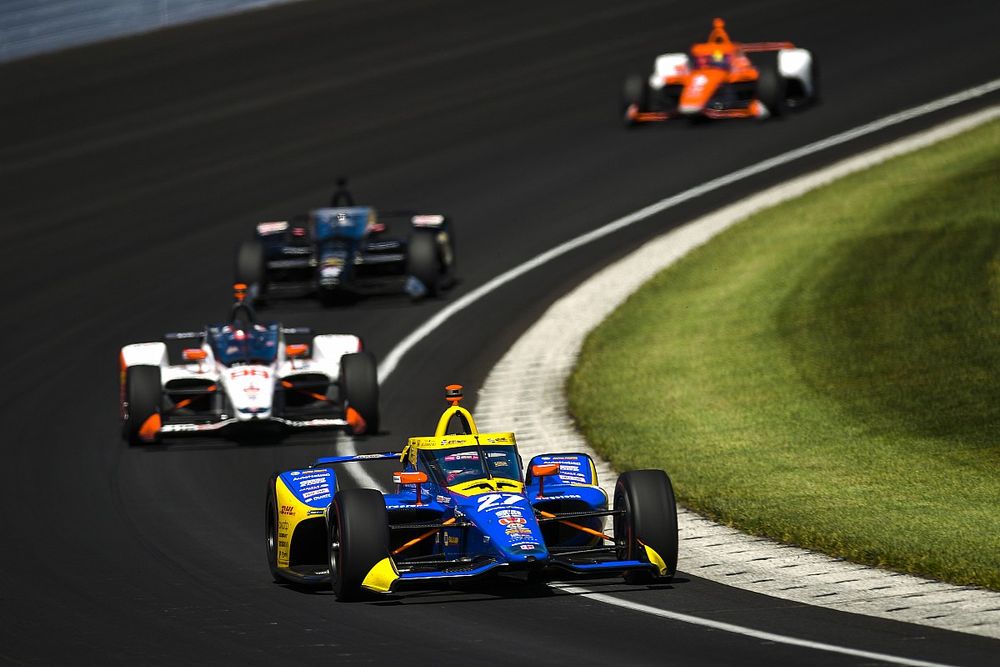Rossi: Aero tweaks, not power boost, will improve Indy 500 action
Alexander Rossi says that IndyCar’s new aerodynamic configuration for the Indianapolis Motor Speedway will improve racing for the Indy 500, and believes a power boost from KERS energy isn’t necessary.

Andretti Autosport-Honda’s 2016 Indy 500 winner was one of four drivers who performed a simulation of a hybrid system last Friday at the legendary 2.5-mile oval, with the drivers running regular race boost (1.3-bar) with brief squirts of extra power (1.5-bar) to represent the expected power delivery of a KERS system discharging stored energy.
IndyCar president Jay Frye was not wholly convinced by the feedback, echoing the ambivalence shown by Rossi, Scott Dixon of Chip Ganassi Racing-Honda, Josef Newgarden (Team Penske-Chevrolet) and Patricio O’Ward (Arrow McLaren SP-Chevrolet).
“It’s a pretty big horsepower boost with the push-to-pass,” said Rossi afterward. “We’re going to have to look at it and see if it changes anything for the better or worse.
“It’s definitely different. We got that test accomplished and have some hard data to look at for the future.”
Asked outright if he felt the change would be helpful, Rossi responded “I do not,” going on to explain that the testing that the same quartet carried out last fall at the Speedway – improving the ability of the cars to run closer together through turns – had been the step forward that was required.
“I think there are always areas to improve the oval package and those areas are pretty clear and understood from all of us,” he said.
"We all had the same balance shifts and sensations. This is attempting to be a solution to the problem…
“I don’t necessarily think that what we are looking for is a power solution. There is a long list of solutions trying to improve what we have and this is just crossing one off the list. Is it good? Is it worse? Is it the same? And what can we do to adjust it for the future?
“Everything that we found in the November test from the aerodynamic side that was a positive and was already on the cars today. So that package that we adjusted for 2021 already exists. What we had here is what we’ll race in May."

Alexander Rossi, Andretti Autosport Honda, Scott Dixon, Chip Ganassi Racing Honda, Josef Newgarden, Team Penske Chevrolet
Photo by: IndyCar Series
Six-time and reigning IndyCar champion Dixon said there was “loads of difference” to the cars running 1.5-bar boost in a pack.
“It’s a lot of power and some of the durations are quite long. It was 10 seconds of 20 kPa (0.2-bar). I don’t know what that is, maybe 50, 60 or 70 horsepower.
“Especially in car that’s trimmed out, your average lap speed will jump by a couple of miles per hour. You know, the tow is still very strong here. I think we’re still trying to figure out what areas need to be worked on and I don’t necessarily think it’s the acceleration of the car on the straight.
"For me, it’s more a function of how it gets through the corner, how close you can run and how the dirty air affects the front of the car. That for me is a bit of a standout."
Be part of the Autosport community
Join the conversationShare Or Save This Story
Related video
Subscribe and access Autosport.com with your ad-blocker.
From Formula 1 to MotoGP we report straight from the paddock because we love our sport, just like you. In order to keep delivering our expert journalism, our website uses advertising. Still, we want to give you the opportunity to enjoy an ad-free and tracker-free website and to continue using your adblocker.



















Top Comments